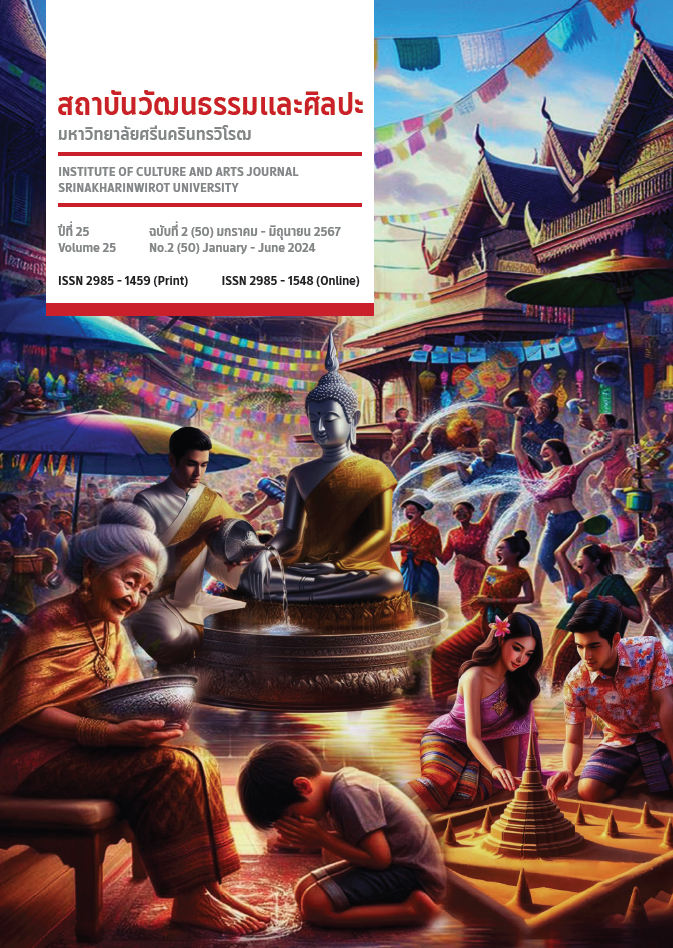การสร้างสรรค์ชุดเครื่องดนตรีสนาม สำหรับเด็กที่มีความบกพร่องทางสติปัญญาภาษาไทย
คำสำคัญ:
ชุดเครื่องดนตรี, เครื่องเล่นสนาม, เด็กที่มีความบกพร่องทางสติปัญญา, ดนตรีไทยบทคัดย่อ
การวิจัยเรื่องการสร้างสรรค์ชุดเครื่องดนตรีสนาม สำหรับเด็กที่มีความบกพร่องทางสติปัญญา นี้มีวัตถุประสงค์เพื่อสร้างสรรค์ชุดเครื่องดนตรีสนาม สำหรับเด็กที่มีความบกพร่องทางสติปัญญา ด้วยฐานความรู้ทางดนตรีไทย และเพื่อศึกษาผลการใช้การสร้างสรรค์ชุดเครื่องดนตรีสนาม สำหรับเด็กที่มีความบกพร่องทางสติปัญญา ในประเด็นการรับรู้และตอบสนอองค์ประกอบของดนตรี ได้แก่ จังหวะ ทำนอง และระดับเสียง
การวิจัยนี้สามารถสรุปผลได้ดังนี้ ชุดเครื่องดนตรีสนามประกอบไปด้วย เครื่องดนตรี 3 ชุดที่สามารถบรรเลงได้ทั้งแบบเดี่ยวและแบบกลุ่ม ออกแบบเป็นโครงสร้างรูปร่างสัตว์ ลักษณะการบรรเลงเป็นเครื่องดนตรีประเภทเครื่องตีที่มีมิติของการกำเนิดเสียงที่แตกต่างกันตามวัสดุที่ใช้ทำ ได้แก่ ไม้ โลหะและพลาสติกสังเคราะห์ (Polyvinylchloride) กำหนดให้มีช่วงเสียงกว้าง 3 ช่วงเสียง (Octave) ได้แก่ เสียงต่ำ เสียงกลาง และเสียงสูง ใช้สี แดง ส้ม เหลือง เขียว ฟ้า แทนเสียงโน้ต โด เร มี ซอล ลา
ผลของการทดลองให้เด็กที่มีความบกพร่องทางสติปัญญากลุ่มตัวอย่าง 7 คน เล่นชุดเครื่องดนตรีสนาม พบว่า เด็กมีการรับรู้และตอบสนองต่อจังหวะ ทำนอง และระดับเสียงอยู่ในระดับดี
Downloads
เอกสารอ้างอิง
กนิษฐา เรืองวรรณศักดิ์. (2560). การออกแบบผลิตภันฑ์ของเล่น. (พิมพ์ครั้งที่ 1). กรุงเทพ: โอ.เอส.พริ้นติ้ง เฮ้าส์. กระทรวงการพัฒนาสังคมและความมั่นคงของมนุษย์ (2563). รายงานข้อมูลสถานการณ์ด้านผู้พิการในประเทศไทย. สืบค้นจาก https://www.m-society.go.th/home.php.
กรมส่งเสริมและพัฒนาคุณภาพชีวิตผู้พิการ. (2563). รายงานข้อมูลสถานการณ์ด้านผู้พิการในประเทศไทย ประจำปี 2563. สืบค้นจาก https://dep.go.th/.
จิรวัฒน์ โคตรสมบัติ. (2562). อิทธิพลของดนตรี. สืบค้นจาก https://site.google.com/site/mrjisclassroom/dntri.
ณรุทธ์ สุทธจิตต์. (2541). จิตวิทยาการสอนดนตรี. (พิมพ์ครั้งที่ 1). กรุงเทพมหานคร: สำนักพิมพ์ จุฬาลงกรณ์มหาวิทยาลัย.
เทพิกา รอดสการ. (2556). การสร้างสรรค์ชุดอุปกรณ์ดนตรีแบบประสมสำหรับเด็กที่มีความบกพร่องทางสติปัญญา.(วิทยานิพนธ์ศิลปกรรมศาสตรดุษฎีบัณฑิต). คณะศิลปกรรมศาสตร์ จุฬาลงกรณ์มหาวิทยาลัย, กรุงเทพฯ.
พิชิต ชัยเสรี. (2553). สังคีตลักษณ์วิเคราะห์เพลงไทย (เอกสารประกอบคำบรรยาย). กรุงเทพมหานคร: คณะศิลปกรรมศาสตร์ จุฬาลงกรณ์มหาวิทยาลัย.
พัชรีวัลย์ เกตุแก่นจันทร์. (2539). แนวการจัดกิจกรรมการเรียนการสอนสำหรับเด็กที่มีความบกพร่องทางสติปัญญาระดับเรียนได้ (เอกสารประกอบการอบรมครูการศึกษาพิเศษ). กรุงเทพมหานคร: มหาวิทยาลัยศรีนครินทรวิโรฒ.
พัชรีวัลย์ กำเนิดเพ็ชร์. (2535). ดนตรีบำบัดเพื่อเด็กพิการ (เอกสารประกอบการประชุมเชิงปฏิบัติการ). กรุงเทพมหานคร: มหาวิทยาลัยศรีนครินทรวิโรฒ.
พัชรีวัลย์ กำเนิดเพ็ชร์. (2536). การจัดบริการการศึกษาของบุคคลปัญญาอ่อน:การเรียนร่วมระหว่างเด็กที่มีความบกพร่องทางสติปัญญากับเด็กปกติ (เอกสารประกอบการอบรม). กรุงเทพมหานคร: โรงพยาบาลราชานุกูล.
มนตรี ตราโมท. (2540). ดุริยางคศาสตร์ไทย ภาควิชาการ. (พิมพ์ครั้งที่ 1). กรุงเทพมหานคร: สำนักพิมพ์มติชน.
โรงเรียนมงฟอร์ตวิทยาลัย แผนกประถม. (2563). กิจกรรมกลางแจ้ง (Outdoor Activities). สืบค้นจาก https://blog.mcp.ac.th/?p=41124.
ศศิมา สุขสว่าง. 2562. การพัฒนาผลิตภัณฑ์ใหม่และนวัตกรรมภายใต้แนวคิด 4Cs model. สืบค้นจาก https://www.sasimasuk.com.
สิชฌน์เศก ย่านเดิม (2558,กรกฎาคม-ธันวาคม). แนวคิดทฤษฎีการสอนดนตรี. วารสารศิลปกรรมศาสตร์ มหาวิทยาลัยศรีนครินทรวิโรฒ,19(2), 26-27.
สุกรี เจริญสุข. (2550). ดนตรีเพื่อพัฒนาศักยภาพของสมอง. (พิมพ์ครั้งที่ 3). กรุงเทพมหานคร: วิทยาลัยดุริยางคศิลป์ มหาวิทยาลัยมหิดล.
สุมาลี บัวหลวง. (2557). ผลการใช้เกมการเล่นกลางแจ้งที่มีต่อพฤติกรรมร่วมมือของเด็กปฐมวัย. (วิทยานิพนธ์ศึกษาศาสตรมหาบัณฑิต). สาขาวิชาเทคโนโลยีและสื่อสารการศึกษา คณะครุศาสตร์อุตสาหกรรม มหาวิทยาลัยเทคโนโลยีราชมงคลธัญบุรี, ปทุมธานี.
สำนักการแพทย์ทางเลือก. (2551). ดนตรีบำบัด. (พิมพ์ครั้งที่ 1). กรุงเทพมหานคร: สำนักการแพทย์ทางเลือก กรมพัฒนาการแพทย์แผนไทยและการแพทย์ทางเลือก กระทรวงสาธารณสุข.
สำนักงานกองทุนสนับสนุนการสร้างเสริมสุขภาพ. (2563). การเล่นเป็นวิธีการเรียนรู้อย่างหนึ่งที่เป็นธรรมชาติ. สืบค้นจาก https://www.kidactiveplay.com/content.php?types= learn&content_detailid=272.
สำนักงานมาตรฐานผลิตภัณฑ์ กระทรวงอุตสาหกรรม. (2537). รายงานการสำรวจและวิจัยขนาดโครงสร้างร่างกายคนไทย ระยะที่ 3 พ.ศ.2536-2537. กรุงเทพฯ: สำนักงานมาตรฐานผลิตภัณฑ์ กระทรวงอุตสาหกรรม.
สมใจ ภัติศิริ. (2564). หลักการออกแบบ. สืบค้นจาก http://www.trangis.com/somjaiart/e2_1.php,
อรวรรณ บรรจงศิลป์ และคณะ. (2546). ดุริยางคศิลป์ไทย. (พิมพ์ครั้งที่ 1). กรุงเทพมหานคร: สถาบันไทยศึกษา จุฬาลงกรณ์มหาวิทยาลัย.
Tepika Rodsakan. (January-2013). Comparison of the effects of using traditional Thai Musical instruments and Carl Orff’s instruments on mentally disabled children's perception and reaction to the musical elements.New Research in Arts Studies Proceeding of the 1st International Conferenc for Asia Pacific Arts Studies. Graduate School Indonesia Institute of Arts, Yogyakarta.142-146.
ดาวน์โหลด
เผยแพร่แล้ว
รูปแบบการอ้างอิง
ฉบับ
ประเภทบทความ
สัญญาอนุญาต
ลิขสิทธิ์ (c) 2024 วารสารสถาบันวัฒนธรรมและศิลปะ

อนุญาตภายใต้เงื่อนไข Creative Commons Attribution-NonCommercial-NoDerivatives 4.0 International License.
บทความทุกบทความที่ได้รับการตีพิมพ์ถือเป็นลิขสิทธิ์ของวารสารสถาบันวัฒนธรรมและศิลปะ มหาวิทยาลัยศรีนครินทรวิโรฒ



